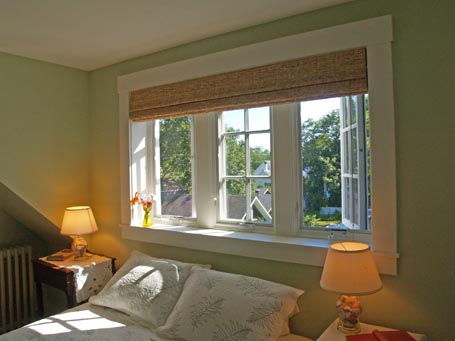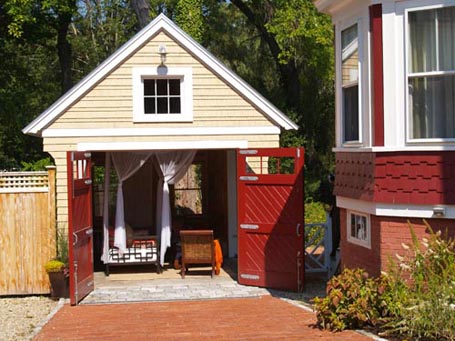
Entries from January 1, 2011 - January 31, 2011
101 things Katie Hutchison Studio (KHS) has learned designing homes, Part four of ten
 Manchester Garage/Garden Room: Design rooms for multiple uses.See Part three of this series here.
Manchester Garage/Garden Room: Design rooms for multiple uses.See Part three of this series here.
31. Modulate ceiling height and treatment. (See Primer: Third dimension.)
32. Design rooms for multiple uses. (See Manchester Garage/Garden Room, above.)
33. Build a team of knowledgeable specialists as consultants.
34. Provide opportunities for prospect and refuge. (See Reading Review: House Thinking.)
35. Where appropriate, arrange rooms “enfilade” (on axis toward a vista). (See House plans that flow.)
36. Design big windows for small houses. (See Design snapshot: Small house, big windows.)
37. The best projects are fun, and fun projects stem from fun homeowners.
38. Use natural materials where possible.
39. Frame thick walls to accommodate more/better insulation and to create deep interior window sills.
40. Include a lookout so occupants can experience “peril” from the safety of their homes. (See Reading Review: House Thinking.)
by Katie Hutchison for House Enthusiast
Ask Katie: Shading a deck
 Example of a wisteria-covered, rear-yard arbor in northern CaliforniaQ: We own a Spanish-style bungalow, built in 1928, in San Jose, California. We added an attached deck to the back of the house that we access from a sliding-glass door. I'm interested in putting up a permanent fabric awning to cover some of the deck in order to give us relief from the sun and to cool down the back of the house (I hope) as it gets direct sun for many hours of the day during the summer. We strive to maintain the historic character of the house in all improvements we make. What do you think?
Example of a wisteria-covered, rear-yard arbor in northern CaliforniaQ: We own a Spanish-style bungalow, built in 1928, in San Jose, California. We added an attached deck to the back of the house that we access from a sliding-glass door. I'm interested in putting up a permanent fabric awning to cover some of the deck in order to give us relief from the sun and to cool down the back of the house (I hope) as it gets direct sun for many hours of the day during the summer. We strive to maintain the historic character of the house in all improvements we make. What do you think?
Alissa from San Jose, CA
A: As a New Englander, I’m not a fan of residential fabric awnings. They generally can’t handle our weather. Sure, folks remove them in the winter around here, but conditions in the shoulder seasons can be problematic too. Over time, the New England climate often takes a toll on awning material -- causing it to fade, yellow, mildew and/or tear.
Regardless of locale, there’s also the matter of the flimsy structures that typically support fabric awnings. Whether retractable or fixed, they can be rather unsightly, hardly a complement to your vintage bungalow.
Instead, I suggest you consider an arbor. A wooden arbor planted with wisteria (or another vine), like the one in the above photo, could provide pleasantly dappled shade. If the arbor covered a six-foot-wide swath of deck off the back of your house, it would be substantial enough to provide some relief from the sun without hogging too much deck space. Christopher Alexander’s pattern No. 167 “Six-foot balcony” in A Pattern Language makes the case for creating such a space six-foot deep, minimum, in order to attract frequent use.
Constructed of cedar (or a similarly rot-resistant wood) the arbor could extend from the rear wall of your home and be supported on the other end by a beam with shaped ends. Substantial, chamfered wooden posts of the same material could in turn support the beam and sit on approximately 30-inch-high broad bases with slightly tapered sides to suit your Spanish-style bungalow. Depending on your home’s exterior finish, the bases could be clad with wooden shingles or perhaps stucco.
Or, you might consider adding a porch roof over a portion of your deck. Again, it needn’t extend much more than six feet or so from the rear face of your house. I’d recommend an exposed wooden roof structure with wooden v-groove planking on its underside (running perpendicular to the rafters) and perhaps supported in a fashion similar to that described in the paragraph above for an arbor. The roofing material could match the main house, or you might want to introduce a contrasting material like standing-seam metal for a lighter, more stream-lined look.
The arbor is a softer solution than the porch-roof solution, but either would provide shade while complementing your home’s historic character.
by Katie Hutchison for the House Enthusiast
Email architect Katie Hutchison (Katie@katiehutchison.com) your general-interest residential design question. Put "Ask Katie" in the subject line and summarize your question in a couple of paragraphs. Include your name, town, and state. Don't include any attachments. Check back with the Ask Katie category to look for Katie's responses to select questions.
101 things Katie Hutchison Studio (KHS) has learned designing homes, Part three of ten
 Edgartown Dormer Renovation: Inhabit the roof with living spaces.See Part two of this series here.
Edgartown Dormer Renovation: Inhabit the roof with living spaces.See Part two of this series here.
21. Maintain one person as the client contact for the duration of a project.
22. A compound of smaller buildings is generally a better design solution than a single, larger building.
23. Ground the building with first-floor porches, wings, and/or pergolas. (See Primer: Recipe for Architectural Charm.)
24. Restore and re-use old, wood windows where possible. (See House Enthusiast posts about this here, here, and here.)
25. Take advantage of a need for significant renovations to upgrade air sealing and insulation.
26. Encourage homeowners to be decisive; don’t overwhelm them with options. (See The behavior economics of design.)
27. Include KHS Construction Administration services for all project contracts that proceed beyond Schematic Design. (See Design Process.)
28. Design legible massing. (See Primer: Recipe for Architectural Charm.)
29. Frame a view; don’t over-expose it. (See Frame it to fathom it.)
30. Inhabit the roof with living spaces. (See Edgartown Dormer Renovation, above, and dormer articles here, here, and here.)
by Katie Hutchison for House Enthusiast
101 things Katie Hutchison Studio (KHS) has learned designing homes, Part two of ten
 Manchester Garage/Garden Room: Detach garages.See Part one of this series here.
Manchester Garage/Garden Room: Detach garages.See Part one of this series here.
11. Design circulation through rooms, rather than halls, where possible. (See House plans that flow.)
12. Use basements for storage and mechanical equipment, not living space (unless they're walk-out basements).
13. Limit the number of steps from grade to the first floor. (See Entry-stoop design tips.)
14. Listen to the story homeowners are telling with their wish list.
15. At minimum, have a “Letter of Agreement” before beginning the design process.
16. Detach garages. (See Manchester Garage/Garden Room, above.)
17. Design in section and plan, simultaneously. (See Primer: Third Dimension.)
18. Manage homeowners’ expectations.
19. Create outdoor rooms via strategic placement of building wings, breezeways, and/or outbuildings. (See Primer: House Garden.)
20. Design it smaller. (See Common Sense Green.)
by Katie Hutchison for House Enthusiast
101 things Katie Hutchison Studio (KHS) has learned designing homes, Part one of ten
 West Tisbury House: Work with the natural site contours, not against them.Over the holidays, I gifted several books from the 101 Things I Learned series, which is created, edited and illustrated by Matthew Frederick. If you haven't heard of the series, it's worth a look. I find the books irresistible.
West Tisbury House: Work with the natural site contours, not against them.Over the holidays, I gifted several books from the 101 Things I Learned series, which is created, edited and illustrated by Matthew Frederick. If you haven't heard of the series, it's worth a look. I find the books irresistible.
Inspired by Frederick's lead, I'm launching a new category with this post: 101 things KHS has learned. Here's the first of a ten-part series on what I've learned designing homes.
1. Fully complete Pre-Design before beginning Schematic Design. (See Design Process.)
2. Respect building/neighborhood context.
3. When possible, work with the natural site contours, not against them. (See Common Sense Green, and West Tisbury House, above.)
4. Protect the best part of the site from the scars of construction. (See Common Sense Green.)
5. Balance lot coverage and open space.
6. Orient buildings/additions to follow the sun. (See Common Sense Green.)
7. Prepare KHS-generated existing condition drawings.
8. Preserve historic character where possible.
9. Clearly differentiate the main entrance from secondary entrances.
10. Don’t be afraid to remove design blunders by others.
by Katie Hutchison for House Enthusiast















